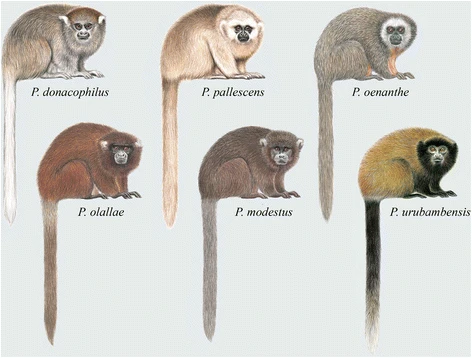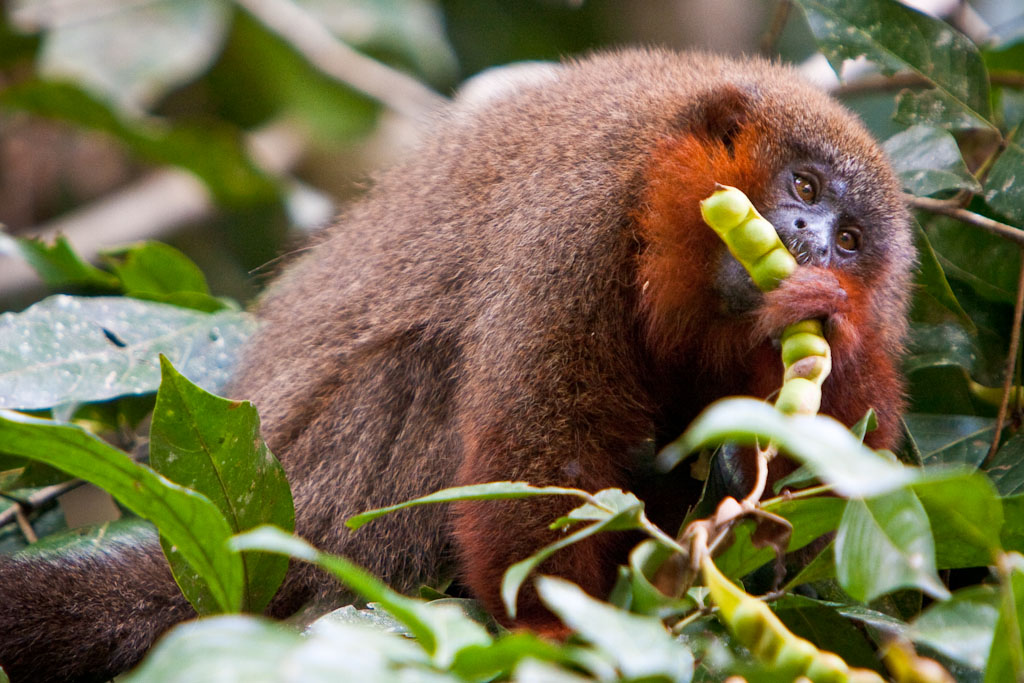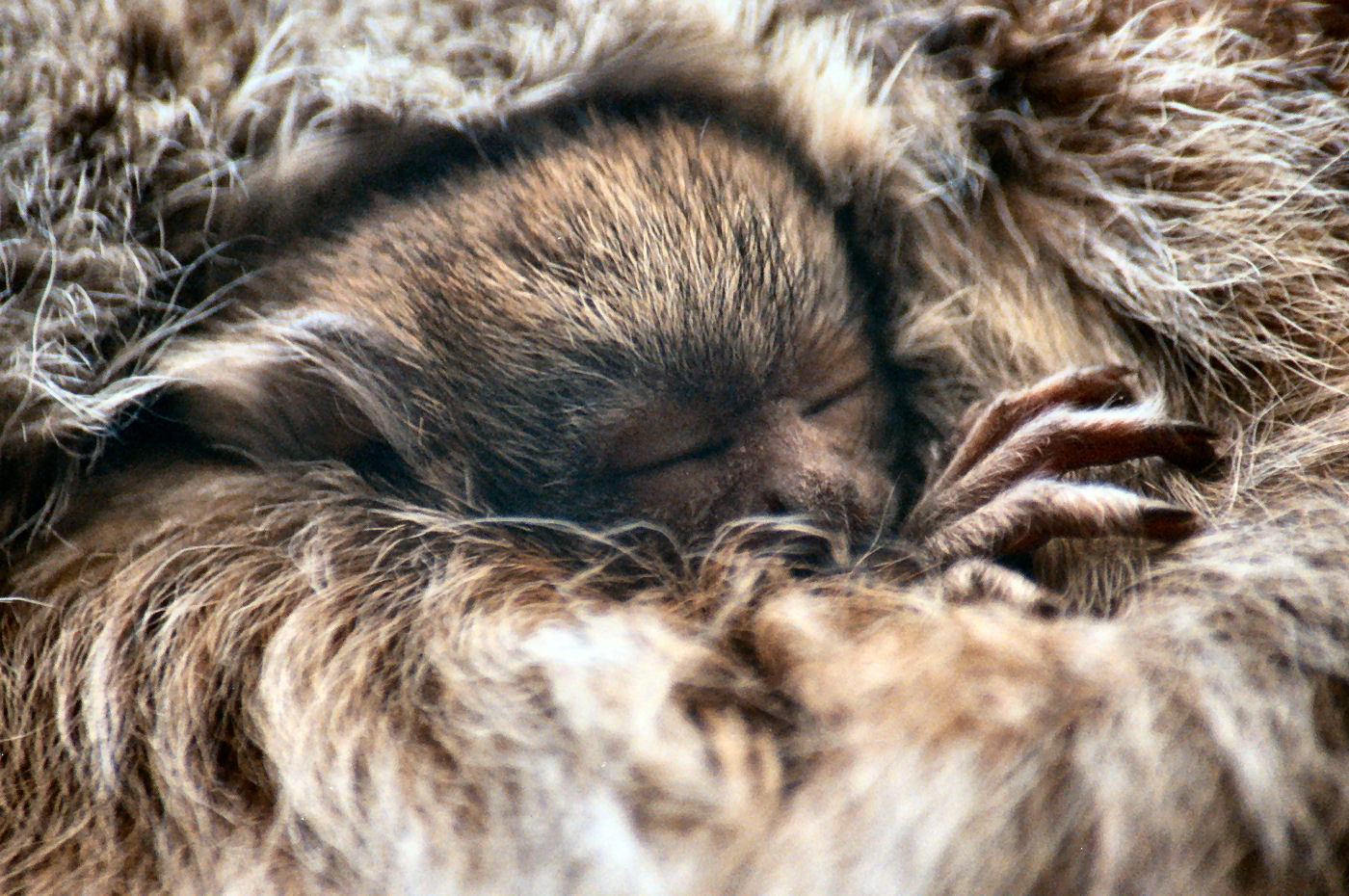|
Plecturocebus
''Plecturocebus'' is one of three genera of titi monkeys. Historically, these monkeys were monotypic taxon, monogeneric, being placed in a single genus: ''Callicebus'' Thomas, 1903. Owing to the great diversity found across titi monkey species, a new genus-level taxonomy was proposed in 2016 that recognises three genera within the subfamily Callicebinae; ''Plecturocebus'' Byrne et al., 2016 for the Amazonian and Chaco titis of the ''moloch'' and ''donacophilus'' groups; ''Cheracebus'' Byrne et al., 2016 for the species of the ''torquatus'' group (Widow titis); and ''Callicebus'' Thomas, 1903 ''sensu stricto'', for species of the Atlantic Forest ''personatus'' group. ''Plecturocebus'' is derived from the Latin forms of three Greek words: plektos, meaning twist or plait, oura, meaning tail, and kebos, meaning long-tailed monkey. All together, this refers to the behavior of many titi monkeys to intertwine their tails when they sit next to each other. Species There are 25 species in ... [...More Info...] [...Related Items...] OR: [Wikipedia] [Google] [Baidu] |
Titi Monkey
The titis, or titi monkeys, are New World monkeys of the subfamily Callicebinae, which contains three extant genera: ''Cheracebus'', ''Callicebus'', and ''Plecturocebus.'' This subfamily also contains the extinct genera '' Miocallicebus, Homunculus'', and ''Carlocebus''. Titi monkeys live in South America, from Colombia, Ecuador and Peru, east through Brazil, and south to Bolivia and northern Paraguay. Description Depending on species, titis have a head and body length of , and a tail, which is longer than the head and body, of . The different titi species vary substantially in coloring, but resemble each other in most other physical ways. They have long, soft fur, and it is usually reddish, brownish, grayish or blackish, and in most species the underside is lighter or more reddish than the upperside. Some species have contrasting blackish or whitish foreheads, while all members of the genus ''Cheracebus'' have a white half-collar. The tail is always furry and is not prehensi ... [...More Info...] [...Related Items...] OR: [Wikipedia] [Google] [Baidu] |
Prince Bernhard's Titi Monkey
Prince Bernhard's titi monkey (''Plecturocebus bernhardi''), also called the zog-zog monkey, is a species of titi monkey in the genus ''Plecturocebus'', first described in 2002. It is named after Prince Bernhard of the Netherlands. They have varying coloration of gray, black, and agouti, with dark orange in certain regions. They are endemic to Brazil, found mostly in disturbed forest environments. While officially listed as least-concern by the International Union for the Conservation of Nature (IUCN), they may, in fact, be at-risk due to human-caused deforestation. Etymology and taxonomy The species is known to locals of the regions it inhabits as a ''zog-zog'' or ''zogue-zogue''; however, that name has also been applied to the coppery titi monkey (''Plecturocebus cupreus''). Its English common name was selected in honor of Prince Bernhard of the Netherlands, who created the Order of the Golden Ark, an award equivalent to knighthood, presented each year to a group of conserva ... [...More Info...] [...Related Items...] OR: [Wikipedia] [Google] [Baidu] |
Brown Titi
The brown titi monkey (''Plecturocebus brunneus'') is a species of titi monkey, a type of New World monkey, from South America. It is endemic to Brazil. It was originally described as ''Callicebus brunneus'' in 1842 and transferred to the newly erected genus ''Plecturocebus'' in 2016. Taxonomy ''Plecturocebus'' are within a subfamily of titi called Callicebinae. Other genera included within this subfamily are the ''Cheracebus'', ''Callicebus'', and ''Plecturocebus;'' which are all still currently extant. The '' Xenothrix, Antillothrix'', '' Paralouatta, Carlocebus, Lagonimico'', and '' Tremacebus'' genera of Callicebinae are extinct. The Urubamba brown titi (''P. urubambensis'') of Peru was formerly thought to be a Peruvian population of ''P. brunneus'', but a 2015 study found it to be a distinct, undescribed species more closely related to the white-eared titi (''P. donacophilus''), and described it as such. The Brown Titi was classified as its own genus in 2016. Due to the ... [...More Info...] [...Related Items...] OR: [Wikipedia] [Google] [Baidu] |
Coppery Titi Monkey
The coppery titi monkey (''Plecturocebus cupreus'') or red titi monkey is a species of titi monkey, a type of New World monkey, from South America. They are found in the Amazon of Brazil and Peru, and perhaps northern Bolivia. It was described as ''Callithrix cupreus'' in 1823. These monkeys have a lifespan of a little over 20 years. These monkeys eat certain fruits, insects, and plants. They live in monogamous pairs with interesting ways for vocalizing and protecting themselves from predators. Location, habitat and activity Coppery titis typically inhabit lowland tropical and sub-tropical forests in areas that flood seasonally. They can also be found in forest understory habitats, young forests, swamp edges, and bamboo thickets. Their populations are mainly found west of the Rio Madeira in Brazil, around the Rio Huallaga in Peru, within the upper Rio Madre de Dios basin in Peru and Bolivia, near the northern Rio-Maranon-Amazonas area, around the Eastern Cordillera in Peru and Ecu ... [...More Info...] [...Related Items...] OR: [Wikipedia] [Google] [Baidu] |
Brown Titi Monkey
The brown titi monkey (''Plecturocebus brunneus'') is a species of titi monkey, a type of New World monkey, from South America. It is endemic to Brazil. It was originally described as ''Callicebus brunneus'' in 1842 and transferred to the newly erected genus ''Plecturocebus'' in 2016. Taxonomy ''Plecturocebus'' are within a subfamily of titi called Callicebinae. Other genera included within this subfamily are the ''Cheracebus'', ''Callicebus'', and ''Plecturocebus;'' which are all still currently extant. The '' Xenothrix, Antillothrix'', '' Paralouatta, Carlocebus, Lagonimico'', and '' Tremacebus'' genera of Callicebinae are extinct. The Urubamba brown titi (''P. urubambensis'') of Peru was formerly thought to be a Peruvian population of ''P. brunneus'', but a 2015 study found it to be a distinct, undescribed species more closely related to the white-eared titi (''P. donacophilus''), and described it as such. The Brown Titi was classified as its own genus in 2016. Due to the ... [...More Info...] [...Related Items...] OR: [Wikipedia] [Google] [Baidu] |
White-eared Titi Monkey
The white-eared titi monkey (''Plecturocebus donacophilus'') also known as the Bolivian titi or Bolivian gray titi, is a species of titi monkey, a type of New World monkey, from eastern Bolivia and an area of western Brazil. The species has a range that extends east from the Manique River in Beni Department, Bolivia to southern Rondônia in Brazil. The southern end of its range includes forests around the city of Santa Cruz de la Sierra. It is a medium-sized monkey with a grey back, orange underside and distinctive white ear tufts. It has an omnivorous diet, eating fruits, other plant materials and invertebrates. It is predated upon primarily by raptors, though felids and other monkey species have been known to attack the species. It is a monogamous species and lives in small groups of two to seven members consisting of the pair and their offspring. The family group has a home range of and the adults have a complex vocal repertoire to maintain their territory. It is also kno ... [...More Info...] [...Related Items...] OR: [Wikipedia] [Google] [Baidu] |
Urubamba Brown Titi Monkey
The Urubamba brown titi monkey (''Plecturocebus urubambensis'') is a species of titi monkey, a type of New World monkey, endemic to Peru. Taxonomy Populations in this species were formerly classified within the brown titi (''P. brunneus''), but a 2015 study found it to be a distinct, undescribed species that also belonged in a different species group of ''Plecturocebus'' from ''P. brunneus'' (the '' P. donacophilus'' group), and thus described it as ''P. urubambensis''. The results of this study were followed by the IUCN Red List, ITIS, and American Society of Mammalogists. Distribution This species is endemic to Peru Peru, officially the Republic of Peru, is a country in western South America. It is bordered in the north by Ecuador and Colombia, in the east by Brazil, in the southeast by Bolivia, in the south by Chile, and in the south and west by the Pac ..., where it is found east of the Tambo River and west of the Urubamba, Manú, and Madre de Dios rivers. De ... [...More Info...] [...Related Items...] OR: [Wikipedia] [Google] [Baidu] |
Alta Floresta Titi Monkey
The Alta Floresta titi monkey (''Plecturocebus grovesi''), also known as the Groves's titi monkey, is a species of titi monkey, a type of New World monkey, endemic to Brazil. It was described from the municipality of Alta Floresta in the state of Mato Grosso. It is a member of the Eastern Amazonian clade of the red-bellied titi monkey (''P. moloch'') group, and is the sister taxon to the clade containing the red-bellied titi and Vieira's titi monkey (''P. vieirai''). It can be distinguished from other species in the ''P. moloch'' group by the combination of its agouti dorsal parts, the bright red-brown venter, the entirely black tail with a white tip, and the light yellow fur on the cheeks. This species is projected to lose up to 86% of its forest habitat under a typical deforestation rate, and is thus classified as Critically Endangered under the IUCN Red List The International Union for Conservation of Nature (IUCN) Red List of Threatened Species, also known as the IUC ... [...More Info...] [...Related Items...] OR: [Wikipedia] [Google] [Baidu] |
Madidi Titi Monkey
The Madidi titi monkey, also known as the GoldenPalace.com monkey or the golden palace monkey, is a titi, a kind of New World monkey, discovered in western Bolivia's Madidi National Park in 2004. Its scientific name is ''Plecturocebus aureipalatii'', the specific epithet meaning "of the Golden Palace", in reference to GoldenPalace.com, an online casino. The casino paid US$650,000 to have the species named after it, with benefits going toward the nonprofit organization that maintains the park where the titi was discovered. Distribution The species was discovered in low-lying lands of northwestern Bolivia, in the forest at the foot of the Andes. Studies indicate that it inhabits the western bank of the river Beni. The extension to the east and north of its range is not known. Preliminary studies indicate that the species is not endemic to Bolivia, with habitats that may extend to the south of Peru (at least to the Tambopata River). Description The Madidi titi has orange-brown f ... [...More Info...] [...Related Items...] OR: [Wikipedia] [Google] [Baidu] |
Olalla Brothers' Titi Monkey
The Olalla brothers's titi monkey (''Plecturocebus olallae'') is a species of titi monkey, a type of New World monkey, endemic to Bolivia Bolivia, officially the Plurinational State of Bolivia, is a landlocked country located in central South America. The country features diverse geography, including vast Amazonian plains, tropical lowlands, mountains, the Gran Chaco Province, w .... There are between 110 and 150 individuals in the wild. References Ollala brothers's titi Mammals of Bolivia Endemic fauna of Bolivia Ollala brothers's titi Taxa named by Einar Lönnberg {{newworld-monkey-stub ... [...More Info...] [...Related Items...] OR: [Wikipedia] [Google] [Baidu] |
Caquetá Titi Monkey
The Caquetá titi monkey (''Plecturocebus caquetensis''), also known as the red-bearded titi or the bushy-bearded titi, is a species of titi monkey endemic to Colombia found in the Department of Caquetá region. Taxonomically, it is a member of the "''Callicebus cupreus'' group" (now '' Plecturocebus cupreus''), following Shunsuke Kobayashi's ''Callicebus'' grouping. It was first described by Thomas Defler, Marta Bueno and Javier Garcia in 2010. It is highly endangered due to habitat fragmentation and a small population. Description Its fur is generally brown, with a lighter tail and chestnut-red undersides, neck and cheeks. It is similar in appearance to the ornate titi and white-tailed titi except that it does not have a white forehead bar, nor does it have the white hands and feet of the ornate titi. It also has a red beard. It has 22 chromosome pairs (not counting the sex chromosomes), with a diploid chromosome number of 2n=46. Its body is approximately 35 cm long and its ... [...More Info...] [...Related Items...] OR: [Wikipedia] [Google] [Baidu] |



